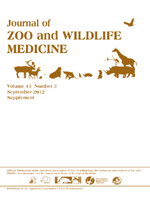During routine health screens for black rhinoceroses (Diceros bicornis minor) in a captive setting, serum iron and ferritin were analyzed as well as total iron binding capacity and total iron saturation. Trends for ferritin and percent iron saturation showed steady increases since 2003 in four of four animals (three males; one female) with two animals (one male; one female) consistently showing higher elevations over conspecifics. The historical diet had been comprised of a commercial or in-house complete pelleted feed; several species of fresh browse, Bermuda grass, alfalfa and timothy hays, as well as enrichment and training items (apples, carrots, sweet potatoes, and a small amount of leafy greens and vegetables). In 2009, one of the three male rhinoceroses showed a threefold increase in ferritin and concurrently exhibited clinical signs of lethargy, decreased appetite, and disinterest in training. The lone female showed a twofold increase; she also became reproductively acyclic in the prior year. The male was immobilized for examination and phlebotomy. During the same time period, a new version of the complete pelleted feed, with a reduced amount of iron, was introduced. Subsequent to the diet change, the male's ferritin levels have consistently declined, and the female started cycling again. Even with these corrective steps to reduce iron levels, levels of iron saturation remained high, and ferritin levels were still above 1,500 ng/ml. Therapeutic phlebotomy was instituted via a rigorous training program that allowed phlebotomies over a 30-min time frame. This was possible because of a long-term training program for the animals, consistent training personnel, routine collection of samples on a monthly basis, and general comfort level of the animals in the restraint chute. The results of this integrated approach showed some significant improvements and an overall positive impact on the animals.
How to translate text using browser tools
2 September 2012
MANAGEMENT STRATEGIES OF IRON ACCUMULATION IN A CAPTIVE POPULATION OF BLACK RHINOCEROSES (DICEROS BICORNIS MINOR)
Natalie D. Mylniczenko,
Kathleen E. Sullivan,
Michelle E. Corcoran,
Gregory J. Fleming,
Eduardo V. Valdes
ACCESS THE FULL ARTICLE
black rhinoceros
Diceros bicornis minor
hemosiderosis
iron storage disorder
nutrition
therapeutic phlebotomy





